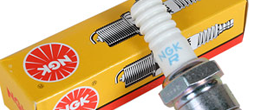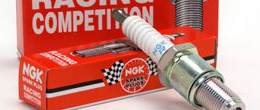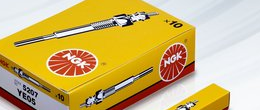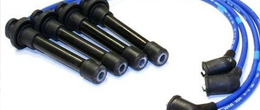The combustion temperature can rise to an abnormally high level so that heat transfer from the interior of the plug is unable to keep pace, leading to trouble such as cracking of the insulation and melting of the electrodes.


1) Breaking of the insulation Type 1 (See Photo 1)
When selecting a plug, make sure that the standard plug will not go outside the optimum temperature range while engine combustion is normal (refer to the “Plug Temperature and its Effects” chart below). If for any reason (water leakage, oil leakage, etc.) the engine starts knocking or detonation occurs, the temperature of the combustion gas will rise sharply and the plug, piston and valves will overheat. Overheating of the plug causes the center electrode to expand, and this can break the insulation.
2) Breaking of the insulation Type 2 (See Photo 2)
This is the situation where deposits (products of combustion of oil, etc.) penetrate into the gap between the center electrode and insulation at the firing end, expanding the center electrode and causing the insulation to break.
Normally, deposits do not penetrate into this gap. If the engine overheats, the engine’s cylinder head may distort. This means that cooling of the combustion chamber will fail which in turn means that knocking will occur more easily. Repeated knocking leads to abnormal pressure and vibration in the combustion chamber. This abnormal pressure and vibration causes the deposits that have accumulated in the combustion chamber to scatter as fine particles and enter gaps in the plug.



3) Melting of electrodes (See Photos 3,4 and 5)
If the firing end overheats far beyond the optimum temperature range, the fuel-air mixture may ignite and combust in advance of the normal ignition timing (this is called “pre-ignition”).
Cause
- Excessive advance of ignition timing
- Fuel-air mixture too lean
- Leakage of cooling water or oil
- Plug incorrectly tightened
- Plug with a low heat rating used
- Plug heat rating reduces by accumulation of deposits

Action to take
- Adjust the ignition timing
- Inspect and adjust the fuel system
- Inspect and repair the leak
- Tighten plugs with the recommended torque
- Use a plug with the standard heat rating
- Change the plug
If the engine is not performing properly and on removing a spark plug it is found that the electrodes have melted or the porcelain insulation has broken, this could be construed as a spark plug fault, but note that some other possible causes for the poor engine performance are problems with the valves, valve seats or pistons.





